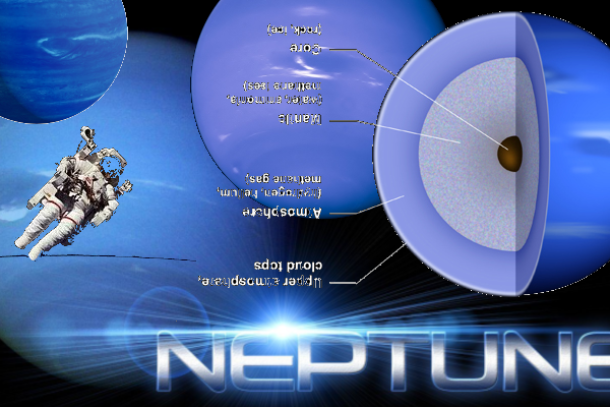NEPTUNE########(((()))))((())(____)))
Neptune may seem like a serene sapphire world at first glance. But don't let its quiet azure hues fool you: The eighth planet from the sun is a wild child.Neptune is the windiest planet in our solar system, whipping up momentous gusts that can reach more than 1,200 miles an hour. That soothing sapphire expanse does reveal some of the whirling chaos below in the form ofbeneath the planet in this image taken by Voyager 2 in 1989. Triton is the only large moon in the solar system that has a retrograde orbit, meaning it circles its planet in a direction opposite to the planet's rotation.</p>Solar day: 16 Earth hours
Solar year: 60,190 Earth days
Atmosphere: 80% hydrogen, 19% helium, 1% other gases
How we study Neptune
It takes a spacecraft a long time to reach Neptune, and we’ve only done it once. NASA launched the nuclear-powered Voyager 2 spacecraft in 1977 to fly past every giant planet in the outer solar system, taking advantage of a rare planetd thin nitrogen atmosphurface.One “Great Dark Spot” captured by Voyager 2 in 1989 could have fit an entire Earth inside. Though it's since disappeared, others have taken its place. In March of 2019, astronomers revealed for the first time that they witnessed the birth of after the Roman god. Astronomers thought that its swirling blue clouds of gas looked like stormy seas.
Neptune was also the patron of horse racing in the Roman Empire. There was only one temple dedicated to him, built near the Circus Flaminius, one of Rome’s horse racing venues.
He is often shown using a trident, a long spear with three prongs. According to
giant, though the ice isn’t anything like what you’d find in your freezer, with temperatures likely reaching
y visible in this image of the planet, taken in 1989 by Voyager 2.
PHOTOGRAPH COURTESY NASA
The calculations were finally confirmed in 1846 when German astronomer Johann Gottfried Galle used Le Verrier's predictions to locate the ice giant, which was dubbed Neptune after the Roman god of the sea.Frosty but hot
Neptune is just one of twoaptured by Voyager 2 as it departed the Neptune system on 31 August 1989. South is at bottom; Voyager 2's flyby over Neptune's northern hemisphere bent the spacecraft's trajectory downwards out of our solar system's orbital plane.Image: NASA / JPL-Caltech / Justin Cowart
Neptune Facts
Average temperature: -201°C (-331°F) where atmospheric pressure equals sea level on Earth
Roman myth, Neptune often used his trident to cause earthquakes and to create new lakes and seas.At such a distance from Earth, Neptune is the sol
<p>The largest of Neptune's 13 moons, Triton is one of only three objects in the solar system known to have a nitrogen-dominated atmosphere. The others are Earth and the Saturn moon Titan.</p>
<p>Bands of clouds streak across Neptune in this image snapped by Voyager 2. The planet's blue color comes from methane in the atmosphere and another component that's a mystery to astronomers.</p>
1 / 4
<p>Neptune's Great Dark Spot is clearly visible in this image of the planet, taken in 1989 by Voyager 2. </p>
NEPTUNENeptune's Great Dark Spot is clearlstery in the 1800s. After the discovery of Uranus at the turn of the century, astronomers noticed it seemed to be affected by a strange gravitational tug. This oddity led British mathematician John Couch Adams to calculate Neptune's potential position in the 1840s. A couple of years later, French astronomer Urbain Le Verrier did the same.
<p>Neptune's Great Dark Spot is clearly visible in this image of the planet, taken in 1989 by Voyager 2. </p>
<p>Neptune's largest moon, Triton, hovers
of its greater distance from the sun. Still, according to NASA, there may be some other, unknown component of Neptune's atmosphere that colors the world a slightly different hue.
3:55
SOLAR SYSTEM 101
How many planets are in the solar system? How did it form in the Milky Way galaxy? Learn facts about the solar system's genesis, plus its planets, moons, and asteroids.
Celestial tagalongs
Neptune has 14 known moons as of 2019. Its largest celestial tagalong, Triton, is the solar system's only large moon that has a retrograde orbit, which means it zips around Neptune in the opposite direction than its host planet's rotation. This curious orbital direction may be evidence that it wasn't always a moon.
Instead, researchers propose Triton started as a binary system—similar to the dwarf planet Pluto and its moon Charon. As it passed by, Neptune's gravity kidnapped Triton from the pair and trapped it in orbit. Triton has a thin
Why we study Neptune
Just like at Uranus, Voyager 2 found that Neptune’s magnetic field doesn’t cleanly intersect the planet’s core and is tilted significantly away from the north and south poles. No other planet in our solar system has such complex magnetic fields as the
one of Neptune's In Roman mythology, Neptune was the god of the sea and of fresh water. He was also worshipped as a god of horses.
Neptune’s Ancient Greek
that of Earth’s
ar system's only planet that can't be seen in our night sky without a telescope. Even neighboring Uranus, though faint, glints overhead on a clear dark night. That means that Neptune wasn't an easy planet to discover. Some suggest that Galileo Galilei first spotted Neptune as early as 1613. Many believe that he mistook it for a star at the time, yet some scientists think that may not be the case.
Most attribute Neptune's discovery to mathematical mathousands of degrees! Electric currents flowing through this icy-hot ocean may be responsible for powering Neptune’s strong and unusually complex magnetic field.Where Neptune formed and how it got its water isn’t clear. The disk of
ice giants in our cosmic family, along with Uranus. It's blanketed in an atmosphere of hydrogen and helium, with traces of methane, water, and ammonia. Underneath an initial chilly layer, temperatures and pressures rapidly increase.
Here are some facts about Neptune.
His wife was Amphitrite, a goddess who was the daughter of Doris and Nereus.
Neptune was one of the 12 Olympian gods. The 12 gods supposedly feasted all day on nectar and ambrosia, and listened to Apollo playing music on his lyre.
Neptune’s name may have come from the god Nethuns,m3 (15 trillion mi3), Earth could fit inside
One of the most famous statues is the Fountain of N
ary alignment that only happens every 175 years. Voyager 2 passed Neptune in August 1989.
Its instruments measured an atmospheric temperature of -220 degrees Celsius (-360 degrees Fahrenheit), with wind speeds as high as 2,100 kilometers per hour, possibly driven from heat radiating deep within the
By figuring out where Neptune was born and how the planet evolved, scientists learn what conditions in the early solar system were like, around the time life arose on Earth.
Neptune has 14 known moons, half of which were likely captured by the planet’s gravity rather than forming in place. Only one moon, Triton, is big enough to be spherical. It has planet-like characteristics similar to Pluto such as a complex icy surface an
eptune in Florence, designed by Ammannati in 1565. Soon after it was built, the city residents started to wash their laundry in the fountain.
In 1846 the planet Neptune was discovered and was named
ice giants. Voyager 2 also revealed Triton’s relatively young, crater-free surface, indicating geologic processes at work. Further attesting this were fractures, ridges, and lava plains in the north, as well as nitrogen geysers in the south that hinted at a possible subsurface ocean.
With no new space missions to Neptune since Voyager 2, scientists have relied on the Hubble Space Telescope and large ground-based telescopes to regularly observe the planet. The observations have discovered more moons, monitored seasonal storms,
Neptune 63 times
Gravity: 11 m/s², or 1.1 timesriton was c
dust and gas that formed our solar system probably didn’t contain enough material to form Neptune at its current location, 30 times farther from the Sun than Earth. Like the other outer planets, it was probably born closer to the Sun before moving outward, though the Sun would have evaporated its water had Neptune been too close. his image of Neptune and T
equivalent was Poseidon.
He was the brother of Pluto and Jupiter and the son of Saturn and Rhea.massive storms. Nearly as big as the maelstrom that Voyager documented, the baby storm seemed to take shape from bright white clouds between 2015 through 2017, emerging as a full-fledged gyre in 2018.
Dreaming of blue
Orbiting at a distance of roughly 2.8 billion miles from the sun, Neptune is the furthest planet yet discovered in our solar system (that is, after Pluto's reclassification as a dwarf planet in 2006). Neptune rotates quickly compared to Earth, with one day taking 16 Earth hours. But its great distance from the sun means the years are long, requiring 165 Earth years to make one trip around our glowing star.Neptune features in dozens of paintings and there are many statues and sculptures of him. There are statues of Neptune in cities such as Bologna, Gdansk and Bristol.
and even detected gases in Triton’s thin atmosphere.
A Neptune orbiter would help us better understand ice giants by measuring the planet’s magnetic field, mapping gravity variations and atmospheric wobbles to understand the core, and observing how heat is radiated on the planet’s night side. A probe dropped into Neptune’s frigid atmosphere could precisely measure the composition of gases, helping scientists figure out where Neptune formed and how it evolved.
Neptune, along with its cousin Uranus, is the least-explored planet in our solar system, having been visited by a spacecraft only once. Yet we’ve found more Neptune-sized worlds orbiting other stars than any other type of planet. In order to understand other solar systems and figure out whether our
ere and may have started off as a free-roaming dwarf planet. Geysers of nitrogen erupt from Triton’s surface that may be coming from a subsurface water ocean. Future missions would help confirm whether the ocean exists and whether it might be habitable to life as we know it.
Just like Saturn, Neptune has a set of rings shepherded by small moons and made up of cold, icy particles. But its outermost ring is not complete, comprising five distinct arcs. Scientists think the planet’s moon Galatea prevents particles in these arcs from spreading out to complete the ring but no one knows for sure.Neptune and Triton from Voyager 2
NEPTUNE AND TRITON FROM VOYAGER 2 T
planet. Voyager 2 also made the definitive observations of the planet’s rings and saw storms raging across the face of the planet, the largest being an Earth-sized anticyclone similar to Jupiter’s famous Great Red Spot.
China is considering a Voyager-like mission to interstellar space that could make a Neptune flyby and drop off an atmospheric probe. A Triton flyby mission called Trident was proposed to NASA's low-cost Discovery program, but was ultimately passed over in favor of two Venus missions.
The 2023-2032 Planetary Science Decadal Survey — a report produced every 10 years by the U.S. scientific community to guide future NASA missions — recommends sending a spacecraft to Uranus as the highest priority. If commissioned, the Uranus Orbiter and Probe (UOP)
an important Etruscan god. The Etruscans thrived in north and central parts of Italy around 800 BC, although not much is known about them.
Neptune features in the famous book The Aenid, by Virgil. In the book, he helps the Trojan army after Juno, the queen of the gods, tries to destroy their ships.
Deep under its cloud tops, Neptune might sport a vast, roiling-hot ocean of water that envelops its rocky core. But not all scientists agree that the planet is cool enough for such liquid to stick around without evaporating.
Methane in the atmosphere reflects blue light, painting the world in vibrant color. In most pictures, Neptune seems to be a deeper and more brilliant blue than Uranus, which looks like a pale turquoise dot. But Neptune is likely similarly pale as its
75 miles), Neptune is 3.9 times wider than Earth
Volume: 63 trillion kmission launching in the 2030s will paint us a clear picture of where and how Uranus formed, and how it subsequently evolved. Because of the two ice giants' similarity, these insights would also likely apply to Neptune. The mission would also provide us with missing information necessary to understand the migration of the gas giants and the connected evolution of our solar system and early Earth.
atmosphere that seems to be growing warmer, but scientists are unsure why.
Five known rings of rocks and dust encircle N
neighbor and just appears darker in images because
cloudy bands and massive gyres that look like dark smudges on its s
own is unique, we need to learn more about the windy blue world in our own backyard.Like Jupiter and Saturn, Neptune’s atmosphere consists mostly of hydrogen and helium, but it also has methane that absorbs red light, giving it a deep blue hue. Beneath the atmosphere lies an ocean of water, ammonia, and methane, squeezed by intense pressures into a semi-solid state. For this reason, we call Neptune an ice
Average distance from Sun: 4,495 million kilometers (2,793 million miles), or 30 times farther from the Sun than Earth
Diameter: 49,528 kilometers (30,7eptune—all named after astronomers who helped bring to light details about the windy world. The ring names are Galle, Le Verrier, Lassell, Arago, and Adams. Neptune also has several partial rings, known as arcs.
Only one spacecraft has ever visited the dark blue world. Voyager 2 whipped by in 1989, collecting captivating data and images. Though many scientists have proposed additional visits, none have yet been approved.
Until another plan is crafted to visit Neptune, researchers will have to appease their curiosity from afar, capitalizing on observations from the Hubble Space Telescope as well as telescopes that have their bases firmly planted on the ground.






















Prikaži Komentarje
Komentiraj